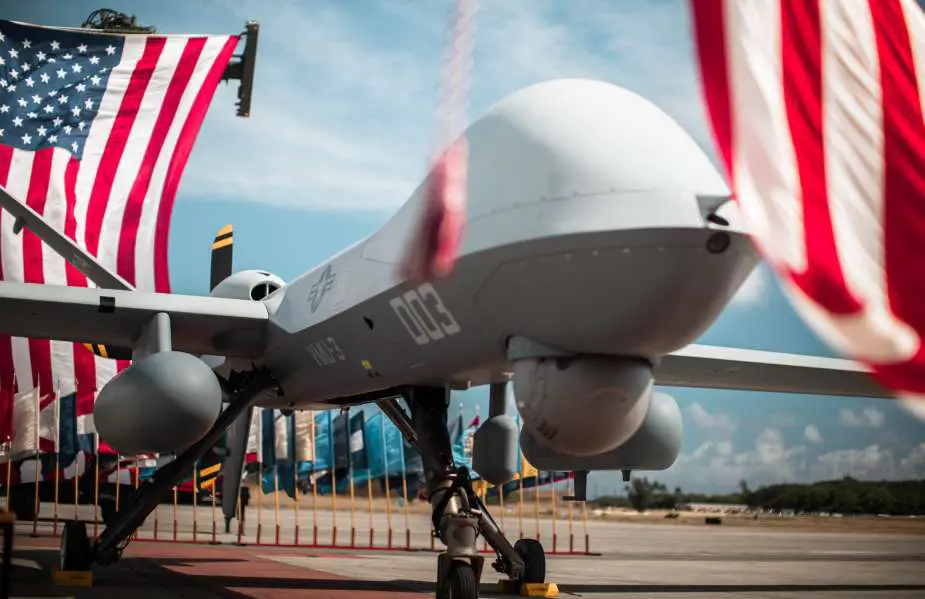Breaking news
US Marine Unmanned Aerial Vehicle Squadron 3 with MQ-9A Reapers now operational.
U.S. Marine Unmanned Aerial Vehicle Squadron 3 (VMU 3) introduced its new Reaper unmanned aerial vehicles in a ceremony at Marine Corps Air Station Kaneohe Bay, Hawaii, last week. It is the first USMC UAV squadron to be operational in the Indo-Pacific region. Aaron-Matthew Lariosa reports in USNI News.
Follow Air Recognition on Google News at this link
 U.S. Marine Corps MQ-9A MUX/MALE is formally unveiled during a ceremony for Marine Unmanned Aerial Vehicle Squadron 3 (VMU-3), Marine Aircraft Group 24, 1st Marine Aircraft Wing at Marine Corps Air Station Kaneohe Bay, on August 2, 2023 (Picture source: US Marine Corps)
U.S. Marine Corps MQ-9A MUX/MALE is formally unveiled during a ceremony for Marine Unmanned Aerial Vehicle Squadron 3 (VMU-3), Marine Aircraft Group 24, 1st Marine Aircraft Wing at Marine Corps Air Station Kaneohe Bay, on August 2, 2023 (Picture source: US Marine Corps)
The sole U.S. Marine Corps UAV squadron operating in the Indo-Pacific region has achieved a noteworthy milestone. This achievement involves the VMU (Unmanned Aerial Vehicle) squadron becoming the first to attain the initial operational capability (IOC) of the service's new MQ-9A Extended-Range Marine Air-Ground Task Force (MAGTF) Unmanned Expeditionary (MUX) Medium-Altitude, High-Endurance (MALE) aircraft. This achievement by VMU-3 came sooner than anticipated, achieving IOC in the third quarter of 2023 instead of the projected fourth quarter. In April, the squadron received its inaugural pair of MQ-9A Reapers and received certification to commence unmanned aerial system operations by June.
Previously, VMU-3 employed less advanced unmanned systems like Boeing ScanEagle, Shadow, and Blackjack during Marine Corps operations in Iraq and Afghanistan. However, with the Marine Corps focusing more on the Pacific region as per their Force Design 2030 strategy, the need for more capable and extended-range Unmanned Aerial Systems (UAS) arose to support new missions and concepts.
Lieutenant Colonel Nicholas Law, the commanding officer of VMU-3, expressed readiness and dedication, stating, "We will leverage these assets to provide comprehensive maritime domain awareness, guiding our combined and Joint Forces. VMU-3 is fully prepared, and we are fully committed," as conveyed in the official press release.
Earlier in the year, the 3d Marine Littoral Regiment tested the application of its new Intelligence, Surveillance, and Reconnaissance (ISR) tools during the sinking exercise of Balikatan 2023 in the Philippines. The Marines demonstrated Force Design 2030 concepts, including Expeditionary Advanced Basing Operations, by offering targeting data to both Philippine and U.S. forces from a base south of Manila, which was over 200 miles away from the exercise location. Reapers from the California Air National Guard’s 163rd Attack Wing contributed to the information flow during the exercise, showcasing the potential of the platform.
Despite being Air Force UAVs, these Reapers demonstrated their transformative potential. Colonel William G. Heiken, the commanding officer of Marine Aircraft Group 24, hailed the Reapers as a "game-changing capability" for both the Marine Corps and the joint force.
The Marine Corps' 2022 Aviation Plan indicates that the MUX High-Altitude Long-Endurance (HALE) system will offer Tier 1 Operational Capabilities. In addition to intelligence, surveillance, and reconnaissance functions, the service plans to equip their Reapers with communication relay capabilities, effectively turning the UAVs into nodes for information exchange. The service's plans from 2022 to 2026 also encompass electronic warfare and airborne early warning radar, expanding the Tier 1 Capabilities. The potential uses for Reapers are diverse, including offensive air support and tactical transportation.
By 2025, the Marine Corps intends to deploy a total of 18 Reapers across two active and one reserve squadron. There are discussions about augmenting the Marine Corps' MUX MALE capacity by introducing three active squadrons, aligning with the objectives of Force Design 2030. This move to incorporate the Reaper into the Marine Corps comes after the cancellation of the MUX program in 2020, which aimed to develop a shipborne UAV for use by Marine Expeditionary Units underway. In the future, VMU-3 will continue to experiment with MQ-9As and further refine the operational concepts of the service.



















